![]()
![]()
![]()
Use LEFT and RIGHT arrow keys to navigate between flashcards;
Use UP and DOWN arrow keys to flip the card;
H to show hint;
A reads text to speech;
20 Cards in this Set
- Front
- Back
|
Glucose: normal, pre-diabetes, diabetes |
Normal: <100 (fasting) Pre-Diabetes: 100-126 Diabetes: >126 Random blood glucose level: >200
A1C: >6.5 (avg blood sugar in 3 months) |
|
|
Sodium (Na+) Ranges |
Normal: 135-145 mEq/L Hyponatremia: 125-130 —water retention, muscle cramps, confusion/delirium Hypernatremia: >160 mEq/L —lack of water, thirst, dry flushed skin, heart failure Sodium = Fluid Balance |
|
|
Vitamin K+ Ranges |
Potassium Normal: 3.5-5.0 Hypokalemia: <3.5 parenthesis, EKG changes Hyperkalemia: >5.0, paralysis, EKG changes Cardiac sensitive, arrhythmia, CV changes |
|
|
Cholesterol Values |
Total cholesterol: > 200 mg/dL LDL: <100, should be low HDL: Should be high Does not travel through your body unless you are having fat (clogs arteries) |
|
|
Hemoglobin Ranges |
Hgb, main component of RBC, transports oxygen Men normal range: 14-17 Women normal range: 12-16 Critical: <5 or >20 Divide by 3 to get HCT (hematocrit) |
|
|
Hematocrit Range |
HCT Percent of plasma to blood, percent of RBC in circulation Times 3 to get Hgb HCT = 3 x Hgb |
|
|
Hemoglobin/Hematocrit Increased and Decreased Symptoms |
Increased H/H: hypovolemia, dehydration, diarrhea — >17 Hgb Decreased H/H: anemia, malnutrition (lack of iron, b12, folate), bleeding, over hydration — <12 |
|
|
Platelet Ranges |
Thrombocytes: essential for clotting Normal: 150,000-400,000 x10^3mm Thrombocytopenia: <50,000: observe for bleeding - call doctor, can go down quick! <40,000: prolonged bleeding <20,000: spontaneous bleeding |
|
|
PT Normal Values |
Prothrombin Time Heparin: 11.0-13.0 seconds Critical Value: >30 seconds |
|
|
Values: WBCs, Magnesium, Phosphorus, Calcium, Chloride, Albumin |
WBCs: 4.3-10.3 Magnesium: 1.5-2.5 (too little muscles tight tachycardia seizure, too much muscles relaxed bradycardia respiratory arrest) Phosphorus: 2.5-4.5 (too little muscles relaxed respiratory failure, too much muscles excited and involuntary contractions) Calcium: 8.5-10.5 (cell signaling, blood clotting) Chloride: 95.0-105 Albumin: 3.5-5.5 (if too low skin will not heal) Hypoalbuminemia: <3.5 |
|
|
Digoxin Therapeutic Range |
Therapeutic Level: 0.8-2 ng/mL Toxic Level: >2 ng/mL Hold if apical <60 |
|
|
Seborrheic Keratosis |
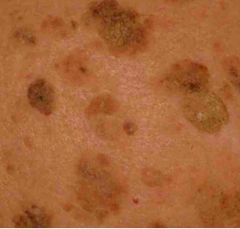
Red/brown color, peel, torso |
|
|
Cherry Angioma |
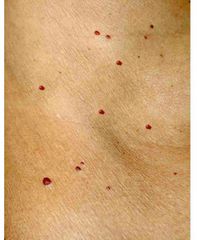
Blood vessels underneath skin, harmless |
|
|
Dermatitis Papulosa Nigra |
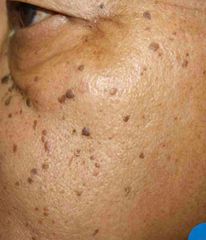
Dark skinned, younger age as getting older |
|
|
Acrochordan |
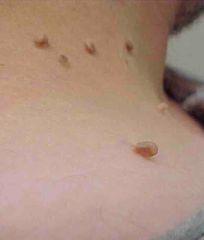
Skin tags, hereditary, off epidermis |
|
|
Lentigines |
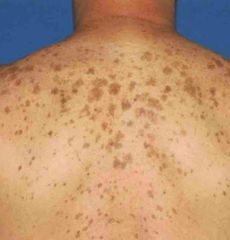
Age spots, liver spots |
|
|
Medication for mild-severe Alzheimer’s Disease (AD) and moderate-advanced AD |
Mild-severe: Aricept/Donepezil Moderate-advanced: Namenda/Memantine |
|
|
Anticholinergics |
Diphenhydramine- Benadryl -Beers criteria- avoid in OA -Dry mouth, confusion, urinary retention, constipation, delirium |
|
|
Antihypertensives |
1. Diuretics: Lasix, HCTZ, potassium sparing diuretics 2. Beta Blockers: ‘olol’, atenolol, metoprolol 3. Ace Inhibitors: ‘pril’, enalapril, captopril 4. Calcium Channel Blockers: ‘pine’, ‘pamil’, amlodipine, nifedipine, verapamil |
|
|
Cholinesterase Inhibitors |
Medications for Alzheimer’s Disease: Aricept/Donepezil, Namenda/Memantine S/E GI upset |

